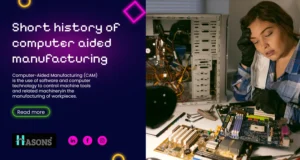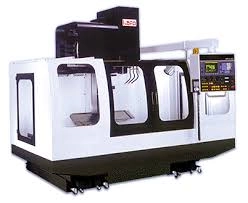Computer Aided Manufacturing
Computer Aided Manufacturing (CAM) has transformed production across industries. This technology allows businesses to automate and optimize manufacturing processes for improved speed, quality, and efficiency.
In this beginner’s guide, we’ll cover everything you need to know about CAM, including:
- A Short History of CAM
- How CAM Works
- Industries Using CAM
- Benefits of CAM
- Skills Needed for CAM
- The Human Role in CAM
- Impact of CAM
A Short History of Computer Aided Manufacturing
Humans have been using tools to manufacture goods for thousands of years. However, it’s only in recent decades that Desktop Computers began assisting in these processes.

The NC Machine Tool Era
Numerical control (NC) marked the beginnings of CAM in the 1940s and 50s. These early systems used punched tape to control machine tools, adding automated control over tasks like welding and grinding.
While revolutionary for large equipment at the time, the inflexibility of punched paper tape limited widespread adoption. Programming changes required an expert to modify the tapes by hand.
The CNC Machine Tool Era
In the 1970s, computer numerical control (CNC) machine tools became viable. CNC systems used computer memory to store machining instructions, making changes fast and simple.
As computers grew smaller and more affordable, CNC made automation accessible to small businesses. Variants like distributed numerical control (DNC) networked CNC machines together for centralized control.
The PC Era
By the 1980s, the personal computer revolutionized CAM. CAD/CAM software allowed users to draft designs and program tool instructions on computer workstations.
These innovations accelerated automation by bridging the gap between design and manufacturing. Today, CAM software continues getting more advanced and intuitive to use.
How Computer Aided Manufacturing Works
CAM software tells manufacturing machinery how to transform raw materials into finished products. It does this by converting CAD blueprints into code that controls equipment.
The CAM Process
- An operator creates a 3D model of the desired part using CAD software.
- CAM software analyzes the CAD model to plan machining paths and actions.
- The resulting toolpaths convert into NC code (G-code)
- The CNC machinery follows these instructions to produce the part precisely and repeatedly.
Programming is tailored to the machine, material, and end product. As designs change, programmers tweak the code accordingly.
Ongoing sensors and automation eliminate the need for human oversight over every manufacturing step. However, skilled technicians still ensure systems run properly.
Industries That Use Computer Aided Manufacturing
CAM brings automation to nearly every industry that makes tangible products at scale. Let’s explore some of the leading sectors using this tech:
Aerospace
Aircraft have countless intricately designed parts produced in low volumes. CAM programming guides precise machining for these components.
Medical Devices & Equipment
Machines tailor surgical instruments and implants to match patient anatomy. CAM makes personalized medical solutions viable.
Automotive
Automakers face immense cost and safety pressures. CAM optimizes efficiency to balance quality with production volume.
Consumer Electronics
Electronics have short lifecycles and quickly shifting demands. CAM allows adjusting established manufacturing lines for new products.
Industrial Machinery
Factory machines require robust and reliable construction. CAM automates everything from framing to fittings.
From prosthetics to smartphones, virtually every manufactured product now involves CAM somewhere along the process. And continual software improvements allow small scale use across more niches.
The Benefits of Computer Aided Manufacturing
CAM provides manifold advantages that explain its widespread adoption across industries:
- Consistent Quality
Machinery precisely executes instructions for uniform results over long production runs. This reduces defects and maintains standards.
- Flexibility
Altering CAD models instantly updates CAM toolpaths. This agility helps manufacturers pivot quickly.
- Complexity
Intricate designs with many parts pose no problem for automation guided by CAM.
- Efficiency
CAM optimizes machining sequences while eliminating pauses. This results in faster, low waste output.
- Staffing Requirements
Automating repetitive manual work reduces labor expenses. Skilled technicians monitor multiple machinery simultaneously.
- Cost Savings
Combining faster production with lower labor and waste saves manufacturers money. Parts also require less refining and reworking.
- Workplace Safety
Removing workers from dangerous industrial environments protects employee health.
These meaningful measurable improvements make CAM an appealing investment despite considerable upfront costs.

What Skills Are Needed for Computer Aided Manufacturing?
Effectively managing CAM systems requires professionals with diverse specialized talents:
Technical Expertise
Engineers adept at using CAD/CAM software direct digital instructions for machinery. Proficiency in materials science helps anticipate how designs will manifest physically.
Programming
CAT programmers focus specifically on preparing NC code to guide equipment. This requires strategic planning to optimize sequences.
Analytic Abilities
Data skills allow adjusting CAM programs based on measured output and continuous feedback. Identifying early warning signs of suboptimal performance is also key.
Troubleshooting
When things go wrong, technicians diagnose and resolve mechanical, electrical and automation issues so production resumes smoothly.
Creative Thinking
Innovating new manufacturing solutions requires seeing possibilities and pushing boundaries beyond conventional designs.
Mastering CAM isn’t easy. But for those willing to learn, this career path offers ample long-term rewards.
The Continued Role of Humans in Computer Aided Manufacturing
While CAM automates major elements of manufacturing, skilled staff remains vital:
Programming
Humans turn CAD models into optimized CAM toolpaths that account for available machinery, materials, quality requirements and other unique variables.
Operation
Technicians prepare equipment, load raw materials, monitor systems, perform maintenance and handle exceptions that exceed automation capabilities.
Quality Assurance
Production workers conduct spot inspections, test finished products, analyze defects and trace causes back to either code or equipment issues.
Innovation
Engineers and programmers customize one-off solutions tailored to unsupported edge cases that mainline CAM can’t handle.
Management
Leaders oversee business operations, long-term investments in new machinery, hiring appropriate staff and bridging gaps between design and production teams.
For the foreseeable future, CAM augments rather than replaces humans in manufacturing. The technology handles rote tasks while people provide strategic oversight, creative problem solving and specialized expertise.
The Impact of Computer Aided Manufacturing
The rise of CAM has profoundly disrupted manufacturing over recent decades:
Customization at Scale
What once required artisanal hand craftsmanship is now possible to mass produce and even personalize affordably.
Agility Acceleration
Launching new designs or pivoting production via CAD/CAM upgrades happens exponentially faster versus manual retooling.
Geographic Flexibility
Manufacturing location bears little relation to distribution anymore as machinery standardizes.
Startup Viability
Barriers that once required major capital investment in equipment and labor lessen. Now hardware costs drop as CAM amplifies individual productivity.
Displaced Workers
While positive for companies and consumers overall, CAM eliminates many low and mid-level factory roles. Transitioning displaced staff to operate higher value facilities remains an ongoing challenge.
Safety & Health
Removing people from dangerous industrial environments carries huge benefits alongside psychological downsides of perceived redundancy.
Balancing these various stakeholder tensions keeps CAM advancement ethical and sustainable. But used judiciously, this technology should keep improving lives when thoughtfully managed.
Final Thoughts on the Future of CAM
Computer aided manufacturing has already reshaped modern production. And innovators continue finding new ways to apply CAM that enhance manufacturing:
Internet of Things Integration
Connecting machinery to a shared data ecosystem improves remote monitoring while centralized AI handles predictive fleet maintenance and performance benchmarking.
Customized Production
Programming tailored to each customer allows mass customization of Bespoke products once impossible through manual methods alone.
Rapid Prototyping
Agile CAM systems allow quick transitions from concepts to first articles for design testing and refinement prior to final production versions.
Decentralized Manufacturing
Compact desktop CNC machines combined with CAM mean small businesses and creators can build products locally on demand.
Sustainable Production
Dialing in processes to minimize waste will help make modern manufacturing cleaner and more earth friendly.
Already vital for factories across nearly every industry, CAM will only become more capable, accessible and essential in years ahead. Harnessing this amazing technology for human betterment poses one of this century’s greatest opportunities.
| If you are reading Computer Aided Manufacturing then also check our other blogs: | |
| Computer Virus | First Electronic Computer |
Computer Aided Manufacturing
Hopefully this beginner’s guide gave you a helpful overview of computer aided manufacturing. By automating intricate production processes, CAM promises to further optimize modern manufacturing for generations ahead!
